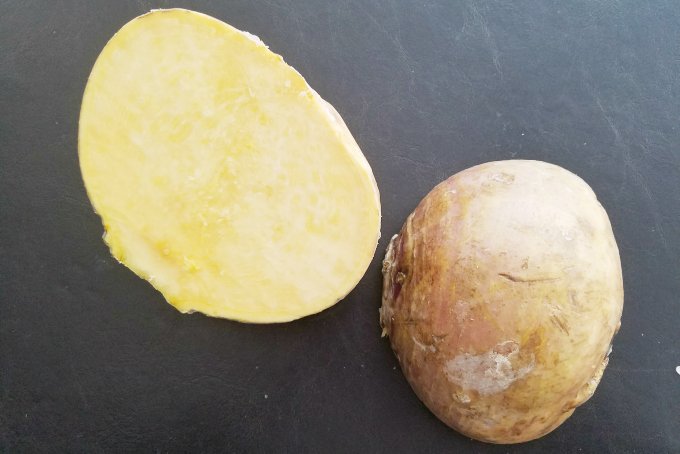I asked the kids what produce we should do this week and kid number 2 said “rutabaga.” He just likes the word, but rutabaga it is. I happen to think rutabaga is a fun word too and I love adding it to soups. Used in moderation it adds a delightfully savory flavor but let’s not do rutabaga an injustice. It’s good for much more.

What is Rutabaga
Rutabaga is a root vegetable in the cruciferous/brassica family. Yes, just like broccoli and cauliflower.
Why Eat Rutabaga
Rutabaga has protein and fiber and is a great substitute for potatoes as it has less carbohydrates. It is also an affordable substitute when you are watching your budget. Raw rutabaga has 38% of your daily Vitamin C and 10% of both Vitamins B1 and B6. Nutrition aside, it can be easy to fall into the rut of eating the same old produce over and over. It’s good to change things up a bit flavor and nutrition profile wise.
How to Choose Rutabaga
Rutabaga are generally found near squash in the produce department. Look for a firm rutabaga without soft spots or gashes. They are often quite large – don’t be looking for something the size of a potato! The most recent rutabaga I purchased was between 2-3 pounds. They are covered in wax to help protect them and you will peel it off before using – with a vegetable peeler.
How to Use Rutabaga
You can eat rutabaga raw, baked, roasted, boiled, braised, steamed, and stir-fried. It is most commonly used in soups, mashed in place of or mixed with potatoes, or roasted.
Preserving Rutabaga
You are able to can rutabaga by pressure canning. However, it generally becomes discolored and the flavor gets stronger. I’ll stick to fresh or frozen.
Blanching Rutabaga
- Bring stock pot 2/3 full of water to a boil.
- While water is heating, wash, peel, and cube rutabaga.
- Prepare a bowl of ice water (to stop the cooking process and cool the rutabaga after blanching).
- Add rutabaga to boiling water.
- Blanch for 3 minutes.
- Remove rutabaga from water and give a quick ice bath (approximately 3 minutes).
- Drain, then package and freeze.
- TIP 1: Flash Freezing: Spread cubes out on a cookie sheet that’s been covered in parchment, waxed, or freezer paper. Put in freezer for 1 hour then package as you wish for freezing.TIP 2: I use my salad spinner to get excess water off my produce after blanching and before freezing.
Recipes with Rutabaga
Coming soon…


Oh I can not wait to try tjis. It is an “old” vegetable that is making a comeback. Hopefully I will use this as a side with some pork chops Sunday. Thanks again.
.
Angie, this would be perfect with pork chops! My mouth is watering just thinking about it. I hope you can find some.